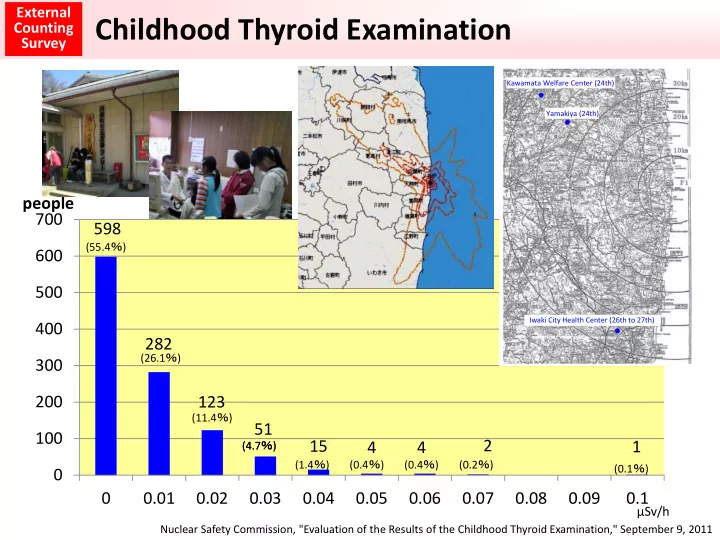

External Childhood Thyroid Examination Counting Survey Kawamata Welfare Center (24th) Yamakiya (24th) people 700 598 (55.4 % ) 600 500 Iwaki City Health Center (26th to 27th) 400 282 (26.1 % ) 300 200 123 (11.4 % ) 51 100 2 15 1 (4.7 % ) (4.7 % ) 4 4 (1.4 % ) (0.4 % ) (0.4 % ) (0.2 % ) (0.1 % ) 0 0 0.01 0.02 0.03 0.04 0.05 0.06 0.07 0.08 0.09 0.1 μSv/h マイクロシーベルト /h Nuclear Safety Commission, "Evaluation of the Results of the Childhood Thyroid Examination," September 9, 2011
Internal Exposure Measurement Using a Whole‐body External Counting Counter Survey Whole‐body counter (WBC): A device to measure radiation from radioactive materials within the body It can measure radionuclides emitting γ‐rays, such as Cs‐134 and Cs‐137. Whole‐body counter (WBC) When radioactive materials have entered the body When radioactive materials When radioactive materials Radiation detector have not entered the body have entered the body Internal cumulative 10 4 Internal 100000 100000 10 4 dose of naturally Internal cumulative 137 Cs occurring K‐40 cumulative dose 40 K dose of cesium 40 K 662keV of naturally 1461keV 10 3 1461keV 75000 75000 10 3 occurring K‐40 Count Count 10 2 50000 10 2 50000 10 1 Examinee 10 1 25000 25000 Examinee Background (phantoms) Background (phantoms) 10 0 0 10 0 0 0 500 1,000 1,500 0 500 1,000 1,500 γ‐ray energy (keV) γ‐ray energy (keV) keV: kilo‐electron volts
Results of the Internal Exposure Measurement Using External Counting a Whole‐body Counter Survey Targeting the residents of the Evacuation Areas and the areas where internal and external exposure doses are likely to be higher than in other areas based on the results of the environmental monitoring survey, etc. (Yamakiya District in Kawamata Town, Iitate Village and Namie Town), the internal exposure measurement using a whole‐body counter commenced on June 27, 2011. The targeted areas were expanded sequentially, and measurements were conducted for a total of 328,354 people by November 30, 2017. For over 99.9% of them, committed effective doses due to Cs‐134 and Cs‐137 were below 1 mSv and even the maximum measured value was below 3 mSv. Measured values were all unlikely to cause any health effects. (i) Targeted local governments: All 59 municipalities in Fukushima Prefecture (ii) Organizations that conducted the measurement Fukushima Prefecture; Hirosaki University Hospital; Minamisoma City General Hospital; Japan Atomic Energy Agency; Niigata Prefecture Radiation Examination Office; Hiroshima University Hospital; Nagasaki University Hospital; Japanese Red Cross Otsu Hospital; Mori no Miyako Industrial Health Association; National Hospital Organization Kanazawa Medical Center; Ehime University Hospital; and the National Institute of Radiological Sciences (iii) 'Mobile measurement' using whole‐body counter vehicles outside Fukushima Prefecture Fukushima Prefecture runs whole‐body counter vehicles for mobile measurement so that evacuees outside the prefecture can also receive measurement. By March 2016, mobile measurement was conducted in 38 prefectures including the Tokyo Metropolis (other than Aomori, Ibaraki, Niigata, Ishikawa, Shiga, Hiroshima, Aichi and Nagasaki Prefectures), where there is no permanent organization to which Fukushima Prefecture commissions the measurement. (iv) Measurement results (committed effective doses) (Results up to November 2017 were released on December 26, 2017. Jun. 27, 2011 – Feb. 1, 2012 – Total Jan. 31, 2012 Nov. 30, 2017 Less than 1 mSv 15,384 people 312,944 people 328,328 people 1 mSv 13 people 1 person 14 people 2 mSv 10 people zero 10 people 3 mSv 2 people zero 2 people Total 15,409 people 312,945 people 328,354 people * Committed effective dose: Assuming that until the end of January 2012, a person ingested radiation once on March 12, 2011, and, from February 2012 onward, a person orally ingested the equal amount of radiation every day from March 12, 2011, to the day preceding the measurement date, the person's lifetime internal doses are calculated by summing up the doses for fifty years in the case of an adult and for the years elapsed until becoming 70 years old in the case of a child. Prepared based on the website of Fukushima Prefecture, "Results of the Internal Exposure Measurement Using a Whole‐body Counter"
External Internal Exposure due to Foods Counting Survey • Radioactive cesium is eliminated from the body over time. • The internal exposure measurement using a whole‐body counter being conducted at present examines the effects of radiation that is ingested orally on a daily basis. • Measured values exceeding 1 mSv are considered to be mostly caused by radiation derived from wild plants or animals . Since March 2012, values exceeding 1 mSv have not been detected. * Reference:p.73 of Vol. 2, "Mushrooms, Mountain Vegetables and Wild Bird and Animal Meat" Q. What if the measurement using a whole‐body counter detected any value exceeding the detection limit? A. The relevant person may have eaten a lot of foods – not allowed in commercial markets – that contain radioactive cesium at high concentrations, e.g., wild mushrooms, wild plants, wild bird and animal meat (wild boars, bears, etc.). Prepared based on the following: Masaharu Tsubokura, et.al. "Reduction of High Levels of Internal Radio‐Contamination by Dietary Intervention in Residents of Areas Affected by the Fukushima Daiichi Nuclear Plant Disaster: A Case Series," PLoS One. 2014; 9(6): e100302., US National Library of Medicine, National Institutes of Health, Published online 2014 Jun 16
External Self‐Protection against Internal Exposure Counting Survey • General protection against radioactive cesium It is very effective to → Have knowledge on foods that contain a high level of radioactive cesium → Avoid eating the same food continuously →Try to eat a variety of foods produced in diverse areas. • Current status in Fukushima → Con�nued inges�on of radia�on is unlikely except from foods. → There is no significant difference whether one selects foods and water produced locally or selects those produced in other areas. • Obtaining accurate information is extremely important. Prepared based on the material released by the 9th Opinion Exchanges, Foodservice Industry Research Institute (September 3, 2012)
Recommend
More recommend